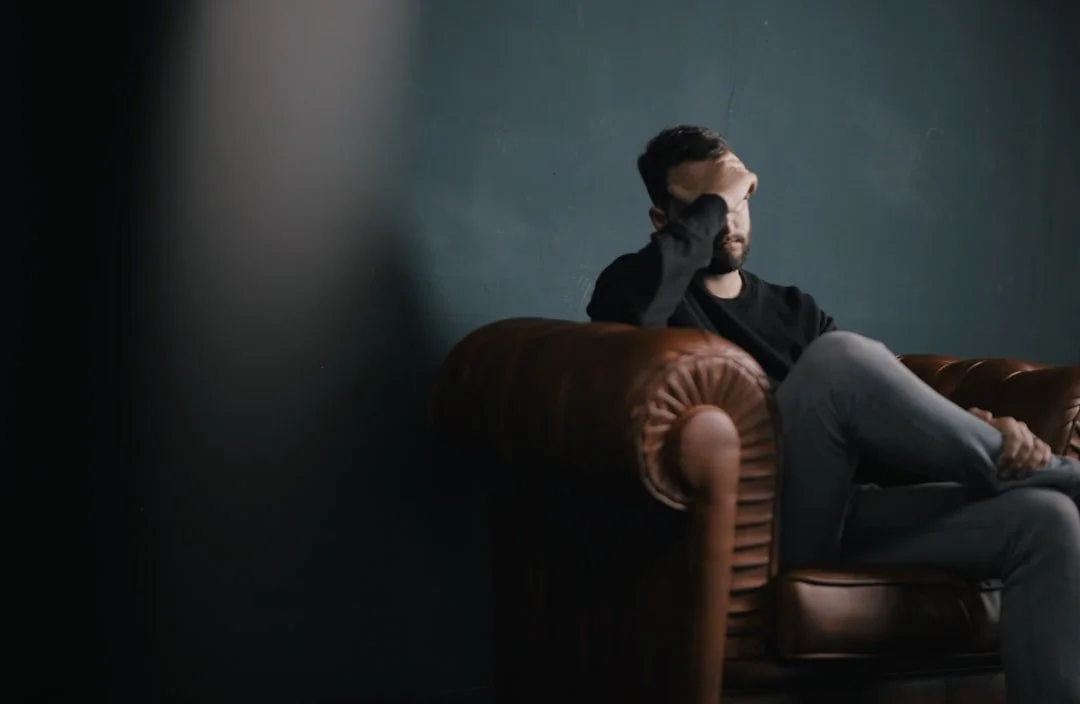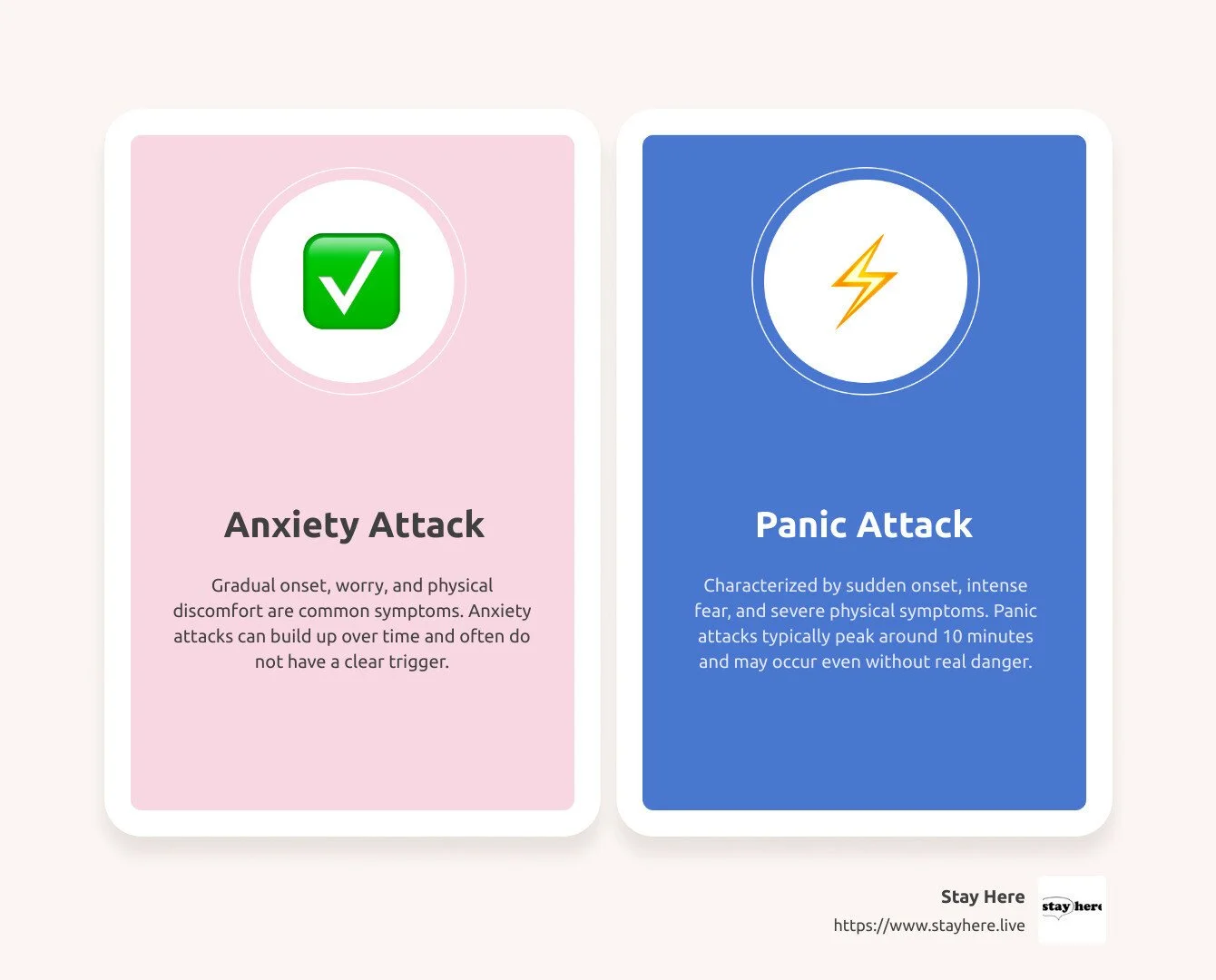Understanding Anxiety Attacks: A-Z Guide to Symptoms and Solutions
If you're searching for quick, clear info on anxiety attacks, here's what you need to know right off the bat:
Symptoms of anxiety attacks can include restlessness, a fast heartbeat, sweating, and feeling dizzy.
Unlike panic attacks, the symptoms of anxiety attacks are generally less intense and can build up over time.
Anxiety can strike without a clear trigger, making everyday situations overwhelming.
Understanding Anxiety Attacks: A-Z Guide to Symptoms and Solutions aims to demystify the experience of going through an anxiety attack, distinguishing it from panic attacks, and providing you with actionable solutions.
Anxiety attacks involve a mix of physical and emotional symptoms that vary from person to person but often include a feeling of dread, rapid breathing, and a racing heart. These attacks can emerge from the pressures of daily life or specific stressors, and sometimes, they spring up without any noticeable cause.
Panic attacks, on the other hand, hit suddenly and with intense fear, sometimes even when there's no real danger. They typically last for a short period, peaking around 10 minutes, but they can leave a lasting impact on your sense of well-being.
For someone in their late teens to early twenties, especially if you're navigating mental health challenges or feeling isolated, distinguishing between these experiences and knowing when to seek help is crucial.
By understanding these differences and recognizing the symptoms, you're taking an essential first step towards managing your anxiety and finding a path to feel more grounded, hopeful, and connected.
Recognizing Anxiety Attacks
Recognizing an anxiety attack is key to managing and overcoming it. Let's break down what you need to know about symptoms, triggers, and how anxiety attacks differ from panic attacks.
Symptoms
Anxiety attacks can sneak up on you. They mix physical and emotional symptoms that can make you feel really uncomfortable. Here are some common signs:
Physical Symptoms: You might feel your heart racing or have trouble breathing. Some people feel dizzy, sweaty, or get a headache. It's like your body is saying, "Hey, something's not right here."
Emotional Symptoms: Fear takes the front seat. You might feel a strong sense of doom, like something really bad is about to happen. It's common to feel out of control or detached from reality.
Triggers
Triggers are like the buttons that start an anxiety attack. They can be anything:
Stress: Big life changes or daily hassles can pile up and push that button.
Specific Situations: Sometimes, just thinking about a situation (like speaking in public or facing a fear) can trigger an attack.
Out of the Blue: Sometimes, there's no clear reason. Your body just decides it's go-time.
Anxiety Attack vs. Panic Attack
It's easy to confuse an anxiety attack with a panic attack, but they're not the same. Here's how they differ:
Intensity: Panic attacks are more intense. They hit hard and fast, often without warning. Anxiety attacks build up more gradually.
Duration: Panic attacks usually peak around 10 minutes and then start to fade. Anxiety attacks can last longer and vary more in intensity.
Fear of Death: During a panic attack, you might genuinely fear you're dying. Anxiety attacks are scary, but they don't usually go that far.
Understanding the Difference:
FeatureAnxiety AttackPanic AttackIntensityGradual buildupSudden and intenseDurationVariablePeaks within 10 minutesFear of DeathLess commonCommon
By recognizing these signs and understanding what triggers your anxiety, you can start to take control. Whether it's through simple strategies like the 3-3-3 rule, breathing exercises, or seeking professional help, acknowledging your anxiety is the first step toward managing it.
In the next section, we'll explore the causes of anxiety attacks, diving into why they happen and how your life experiences might play a role. This understanding can be powerful in finding the right strategies and treatments to help you feel better.
Causes of Anxiety Attacks
Understanding why anxiety attacks happen is crucial. Just like knowing the signs of an anxiety attack, recognizing the causes can help you manage them better. Let's dive into the main reasons why people experience anxiety attacks.
Stress
Stress is a big trigger. When you're under a lot of pressure, your body can react with anxiety. This could be stress from work, school, or personal life. Sometimes, it's a big event, like moving to a new place or losing a job. Other times, it's a bunch of small things piling up.
Trauma
Experiencing something really scary or upsetting can lead to anxiety attacks. This is especially true if you feel like you're reliving that experience. It's like your mind keeps going back to that tough time, and it can trigger an attack.
Genetic Factors
Sometimes, anxiety runs in families. If your parents or siblings have anxiety, you might be more likely to experience it too. This doesn't mean you will for sure have anxiety, but you might be more at risk.
Environmental Factors
Where you live and things happening around you can also cause anxiety attacks. This could be living in a place where you don't feel safe or going through a big change, like starting at a new school. Even watching a lot of scary news can make you feel more anxious.
Each of these causes can affect you in different ways. But knowing them can help you figure out the best way to manage your anxiety. In the next sections, we'll look at how to handle anxiety attacks and what treatment options are available.
Managing Anxiety Attacks
When anxiety feels like it's getting too much, there are several strategies you can use to help calm down. Let's dive into a few practical techniques.
3 3 3 Rule
This simple yet effective method helps bring your focus back to the present, reducing the intensity of an anxiety attack. Here's how it works:
Objects: Identify 3 things you can see around you. It could be a picture on the wall, a plant, or even your own hands.
Sounds: Listen carefully and pinpoint 3 sounds you can hear. Maybe it's the hum of your computer, birds chirping outside, or distant traffic.
Body parts: Move 3 parts of your body. Wiggle your fingers, tap your feet, nod your head. This action helps remind you that you're in control.
Breathing Exercises
Calming breaths and deep breathing are powerful tools to help reduce anxiety. Try this:
Breathe in slowly through your nose, counting to four.
Hold your breath for a count of four.
Exhale slowly through your mouth, counting to four.
Repeat this cycle for a few minutes until you feel more relaxed.
Professional Help
Sometimes, managing anxiety requires professional help, and that's perfectly okay.
SAMHSA's National Helpline (1-800-662-HELP (4357)) is a confidential, free, 24/7, 365-day-a-year service offering information to individuals facing mental and/or substance use disorders.
Cognitive Behavioral Therapy (CBT) is a type of psychotherapy that can be incredibly effective in managing anxiety. It helps you identify and challenge negative thought patterns and behaviors.
Medications: In some cases, doctors may prescribe medications like antidepressants or anti-anxiety drugs. These can help manage symptoms, especially when combined with therapy.
Lifestyle Changes
Making some adjustments to your daily habits can also make a big difference in managing anxiety:
Healthy diet: Eating balanced meals can help regulate your mood and energy levels. Include plenty of fruits, vegetables, and whole grains in your diet.
Regular exercise: Physical activity releases endorphins, which are natural mood lifters. Aim for at least 30 minutes of exercise most days of the week.
Sleep hygiene: Ensure you're getting enough rest. Create a relaxing bedtime routine, keep your bedroom cool and dark, and stick to a consistent sleep schedule.
By incorporating these strategies into your life, you can better manage anxiety attacks and improve your overall well-being. It's important to reach out for help if you're struggling. You're not alone, and there are resources and people ready to support you.
Treatment Options
When it comes to tackling anxiety attacks, there are several paths you can take. Let's break them down into three main categories: Psychotherapy, Medication, and Support Groups. Each has its own set of tools and benefits that can help you manage or even overcome anxiety attacks.
Psychotherapy
Cognitive Behavioral Therapy (CBT): This is a very hands-on approach that focuses on changing negative thought patterns that contribute to anxiety. Think of it like reprogramming a computer. CBT teaches you to recognize and challenge these thoughts, and replace them with more positive, realistic ones. It's like learning to spot lies your brain tells you and knowing how to answer back.
Exposure Therapy: Imagine you're afraid of spiders. Exposure therapy gently and gradually gets you used to spiders, so they're not so scary anymore. For anxiety, it works by facing the fears that trigger your anxiety in a safe, controlled way, reducing their power over you over time.
Medication
Antidepressants: These aren't just for depression. Medications like SSRIs and SNRIs can help balance the brain chemicals that affect your mood and anxiety levels. Think of them as helping to smooth out the emotional rollercoaster.
Beta-blockers: These are often used for heart conditions, but they can also help with physical symptoms of anxiety, like shaking or a racing heart. It's like putting a damper on the body's alarm system.
Anti-anxiety medications: Medications like benzodiazepines can offer quick relief in high-anxiety situations. However, they're usually not for long-term use due to risks of dependency. Think of them as emergency brakes when anxiety gets overwhelming.
Support Groups
Stay Here Crisis Chat Line: Sometimes, just talking about what you're going through can be a huge relief. The Stay Here crisis chat line offers a safe space to share your feelings and get support from people who understand what you're dealing with.
Anxiety Disorders Association of America: This organization provides a wealth of resources, from educational materials to finding support groups. It's like having a guidebook and a community all in one place to help you navigate through anxiety.
Each of these treatment options offers its own set of tools and benefits. You might find one approach works best for you, or a combination of several. The key is to remember that you have options and support at every step of the way. Whether it's through therapy, medication, or leaning on a community, help is available. You're not alone in this journey.
Preventing Anxiety Attacks
Preventing anxiety attacks starts with understanding and awareness. Let's explore simple yet effective steps you can take to keep anxiety in check.
Know the Signs
First off, recognizing early signs of anxiety can be a game changer. Symptoms like restlessness, increased heart rate, or trouble focusing could signal that an anxiety attack might be on the horizon. By noticing these early, you can take steps to manage your anxiety before it escalates.
Avoid Alcohol or Drug Use
It might be tempting to turn to alcohol or drugs as a quick fix for anxiety relief. However, this can actually backfire, making anxiety worse in the long run. Alcohol and drugs can interfere with sleep, mood, and even lead to dependency—all of which can fuel anxiety rather than ease it. So, it's wise to steer clear of these substances or use them very cautiously.
Stay Active
Exercise isn't just great for your physical health—it's a powerful tool for managing anxiety, too. Regular physical activity releases endorphins, natural mood lifters that can also help reduce stress. You don't have to run marathons; even a daily walk or a short yoga session can make a big difference.
Get Help Early
Perhaps the most important step in preventing anxiety attacks is to seek help as soon as you notice signs of anxiety becoming more frequent or severe. Early intervention can make treatment more effective and prevent anxiety from deeply impacting your life. Whether it's talking to a healthcare professional, joining a support group, or exploring therapies like CBT, reaching out is a sign of strength, not weakness.
By integrating these strategies into your daily life, you can create a strong foundation for managing anxiety. It's all about taking proactive steps towards understanding and addressing your anxiety, rather than waiting for it to escalate. With the right support and self-care, preventing anxiety attacks is an achievable goal.
Frequently Asked Questions about Anxiety Attacks
When it comes to anxiety attacks, many people have questions. Let's tackle some of the most common ones in simple terms.
What is the 3 3 3 rule for anxiety?
The 3 3 3 rule is a quick and easy way to ground yourself during an anxiety attack. Here's how it works:
Identify 3 Objects: Look around you. Find and name three things you can see. This could be anything from a chair, a cup, to a picture on the wall.
Listen for 3 Sounds: Close your eyes and listen carefully. Identify three sounds you can hear. Maybe it's the ticking of a clock, birds chirping, or the distant sound of traffic.
Move 3 Body Parts: Finally, move three parts of your body. Wiggle your toes, tap your fingers, or blink your eyes.
This method helps bring your mind back to the present, helping to reduce feelings of anxiety.
How long does an anxiety attack last?
Anxiety attacks can vary in length, but they typically last between a few minutes to half an hour. They often come on suddenly and can feel quite intense, but they usually peak within 10 minutes. While they're scary, they're not life-threatening.
Can anxiety lead to panic?
Yes, anxiety can lead to panic attacks. While anxiety attacks are generally triggered by perceived threats or stressful situations, panic attacks often happen without a clear trigger. They are more intense and involve a strong fear of disaster or losing control, even when there is no real danger. People with an anxiety disorder may experience panic attacks as a symptom of their condition.
Understanding these aspects of anxiety attacks can be a big step towards managing them. If you're struggling with anxiety or panic attacks, reaching out for professional help can make a big difference. There are many resources and treatments available that can help you navigate through these challenges.
Conclusion
As we wrap up our guide on understanding anxiety attacks, it's crucial to remember that hope and recovery are not just possibilities—they are very much within reach. Anxiety attacks can be daunting, and they often feel like insurmountable obstacles. However, with the right tools and support, managing and overcoming them is achievable.
Hope lies in understanding that anxiety attacks are not a life sentence. With every step taken towards understanding your triggers, learning management techniques, and seeking professional help, you're moving closer to regaining control over your life. Progress may be gradual, and that's perfectly okay. Every small victory is a step towards a more peaceful mind.
Recovery is a journey, not a destination. It involves learning to manage symptoms, reducing the frequency and intensity of attacks, and ultimately, improving your quality of life. This journey is deeply personal and looks different for everyone. Some find solace in therapy, others in medication, and many in a combination of treatments. The key is to find what works for you and to remember that it's alright to ask for help along the way.
At Stay Here, our mission is to support you on this journey. We believe in a world where everyone has access to the help they need when they need it most. Our initiatives, from the 24-hour crisis chat line to free therapy services and beyond, are designed to offer support at every stage of your journey. We're here to provide the tools, resources, and community support needed to navigate through the challenges of anxiety attacks.
We also understand the power of community. Sharing your story, listening to others, and knowing you're not alone can be incredibly empowering. Our support groups and forums offer a safe space to connect with others who understand what you're going through. Together, we can build a network of support that uplifts and encourages each other every step of the way.
In conclusion, an anxiety attack is just a part of your story, not the entirety of it. With the right support and strategies, you can write new chapters filled with hope, recovery, and resilience. At Stay Here, we're committed to standing by your side, offering the resources and support you need to move forward. Together, we can face anxiety attacks with strength and hope. Join us in our mission to bring healing and hope to those in need.
You're not alone. We're here to help you find your way back to peace and well-being. Let's take this journey together.
Together, we can save lives. Join us in this vital mission.


